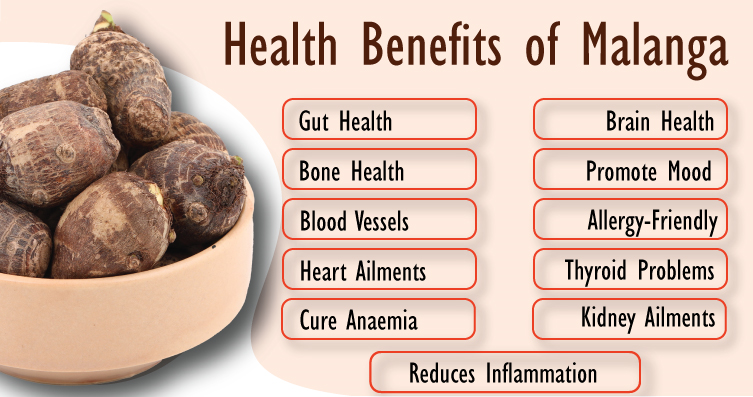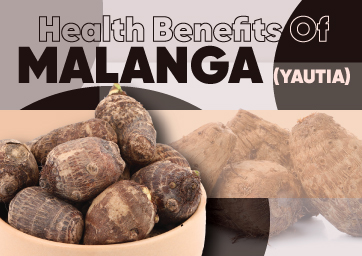Other Names of Malanga (Yautia)
Malanga (Yautia) is native to Northern South America though it is cultivated worldwide. In different parts of the world, Malanga is known under different local names, which are American Taro, Arrowleaf Elephant’s Ear, Barbados Nut Eddoe, Cocoyam, Elephant Ears, Green Arrow Elephant Ears, Malanga, New Cocoyam, Tannia, Uyautia, Yannia Leaf Spinach, Yautia, Yautia Tannia, Yellow Ocumo, Yellow Yautia.
Nutritional Value of Malanga (Yautia)
Malanga is a nutrient-dense, low in fat, and fiber content vegetable. One serving of cooked malanga equals one cup without adding anything else contains:
Besides, Malanga is a rich source of iron, riboflavin, thiamine, and vitamin C.
Health Benefits of Malanga (Yautia)
Malanga (Yautia) provides a host of health benefits to its consumers, which are as follows:

1. Brain Health
Copper affects the pathways such as galactose and dopamine. These neurotransmitters help maintain a good mood, outlook, focus, and energy. The deficiency of copper can result in fatigue, poor mood, concentration issues, and low metabolism. Copper helps utilise various antioxidants like Vitamin C, superoxide dismutase, tyrosinase, and ascorbate oxidase. That supports preventing damage caused by free radicals in the brain and slows down the ageing process and neurodegenerative disease.
2. Thyroid Problems
For proper thyroid functioning, copper is a must. It helps maintain a balance between the activities of the thyroid in association with different minerals like calcium, potassium, and zinc. Besides, it prevents health issues like hypothyroidism and hyperthyroidism. If any of the minerals get exceeded in the body. In that case, it can cause thyroid that leads to several health issues like weight loss or weight gain, fatigue, change in appetite, body temperature, or other symptoms.
3. Promote Mood
According to the research, Vitamin B6 is highly responsible for producing GABA neurotransmitters and serotonin in the brain. These hormones help to maintain a good mood and prevent fatigue, pain, anxiety and depression. Consequently, vitamin B6 prevents mood disorders.
Vitamin B6 supports the production of hormones that cure brain diseases and mood disorders owing to the deficiency in neurotransmitter functions. The supplement Vitamin B6 improves mood and reduces pain, energy, and concentration problems.
4. Cure Anaemia
Anaemia is the situation caused due to the low presence of red blood cells, which causes aches, pain, and fatigue. Vitamin B6 intake in an adequate amount can help reduce these symptoms and prevent them from building further. Because Vitamin B6 supports the production of haemoglobin in the blood, and red blood cells aid in transporting oxygen to the cells and mobilising iron.
5. Blood Vessels
Our blood contains homocysteine, a type of amino acids, that should be in a balanced state. Imbalance in homocysteine levels lead to various diseases. If homocysteine level in blood goes high, it could cause inflammation, heart disease, and blood vessel disease that results in a heart attack.
Vitamin B6 helps in regulating the levels of homocysteine in blood. Its deficiency can damage blood vessel linings and may lead to a stroke or heart attack. One can maintain homocysteine levels in blood by consuming vitamin B6 in the form of folate. Also, vitamin B6 helps in maintaining cholesterol and blood pressure level, one of the main reasons for heart disease.
6. Heart Ailments
Malanga (Yautia) is a rich source of potassium and potassium plays a vital role in managing heart activities. Like the circulation, rhythm of heartbeats as well as blood pressure. According to the studies, if a person consumes a sodium rich and low potassium diet, there are high chances of him/her attracting diseases like hypertension, high blood pressure and cardiovascular diseases. Infact, potassium blends with the minerals such as magnesium and calcium and prevents fluid buildup in the cells. The deficiency of potassium leads to chest pains, irregular heartbeats, and cardiac arrest.
7. Allergy-friendly
In developed countries, food allergies are one of the growing problems in terms of health. However, malanga is not a kind of food that causes allergies in most people. Since allergies and insensitivities are caused due to gluten and malanga is a gluten-free diet. When made into flour, it becomes a great alternative to wheat flour without gluten.
8. Gut Health
Malanga has fibre content which promotes healthy bowel movements and prevents constipation and indigestion. In addition to this, malanga promotes the growth of healthy gut bacteria, which improves gut health and overall immunity. Also, it helps to keep to your sugar levels in check.
9. Bone Health
Malanga helps in maintaining a good health of bones because it contains nutrients like calcium, vitamin C, and phosphorus and these nutrients play a vital role in strengthening your bones health. Also, the consumption of malanga lowers the risk of bone disease like osteoporosis.
10. Reduces Inflammation
Malanga is known to have various antioxidants. Antioxidants which help in fighting with the oxidative stress that causes inflammation and chronic diseases such as cancer and arthritis.
11. Kidney Ailments
Kidney ailments like Kidney stones are caused due to the low level of potassium. Even it’s formulation highly depends on the opposite relation of calcium and potassium. In the presence of low levels of potassium, excess calcium is excreted through the urine which pass through kidneys. Kidney stones are the result of calcium deposits which can be reduced with the high intake of potassium and reducing the chances of forming kidney stones.

How to Eat and Cook Malanga (Yautia)?
Malanga should only be eaten cooked, but how you cook it totally depends on you. You can roast, steam, bake malanga. You can use smashed malanga like potatoes as it is often used as a potato substitute. The use of malanga flour is also popular as it replaces regular all-purpose flour at many places.
If you’re willing to incorporate malanga as a part of your diet, you can start by considering the following recipes.
Malanga (Yautia) Risk and Side effects
Well, there are almost no known risks of consuming malanga until it is being cooked. It is a rich source of various nutrients and a relatively complex carb that is high in fibre. Malaga is safe to eat for both adults and children. For young children who are expanding their diet, they can use mashed malanga as potatoes.
However, the people who are suffering from hyperkalemia and have high potassium level in their blood should keep the potassium intake low in their diet. Symptoms of hyperkalemia include weakness, slowed heart rate, and abnormal heart rhythm. These people should avoid having malanga in their diet.
While malanga is considered an extremely healthy food, its intake in moderation is recommended. For all your dietary needs, you should never rely on malanga and try to incorporate it into a well-balanced diet.
Conclusion
Malanga (Yautia) is a root vegetable full of nutritions. It is native to Northern South America but cultivated and consumed all across the world. It is popular under different names and consumed cooked (roasted, baked, mashed like potatoes and as an alternative to regular flour). It is highly beneficial to health and has less known risks and side effects, if consumed in moderation. Going through the blog, you must have known all the things including the nutritional value of malanga in a single serving. If you haven’t included malanga into your diet yet, include it today and enjoy above-mentioned health benefits. For more such health tips and blogs, keep visiting Kayawell.com and know about what is beneficial for your health.



 Contact Us
Contact Us

 Hospitals
Hospitals
 Doctors
Doctors
 Diagnostic
Diagnostic
 Pharmacy
Pharmacy
 Health Tips
Health Tips
 Blog
Blog


















Comments